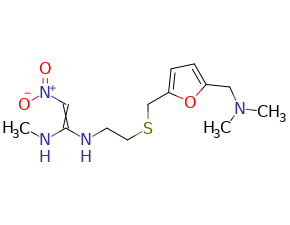
Ranitidin
CAS No. 66357-35-5
Ranitidin( —— )
Catalog No. M18965 CAS No. 66357-35-5
Ranitidine is a non-imidazole blocker of those histamine receptors that mediate gastric secretion (H2 receptors). It is used to treat gastrointestinal ulcers.
Purity : >98% (HPLC)
 COA
COA
 Datasheet
Datasheet
 HNMR
HNMR
 HPLC
HPLC
 MSDS
MSDS
 Handing Instructions
Handing Instructions
| Size | Price / USD | Stock | Quantity |
| 5MG | 32 | In Stock |


|
| 10MG | 41 | In Stock |


|
| 25MG | 74 | In Stock |


|
| 100MG | 116 | In Stock |


|
| 200MG | 210 | In Stock |


|
| 500MG | Get Quote | In Stock |


|
| 1G | Get Quote | In Stock |


|
Biological Information
-
Product NameRanitidin
-
NoteResearch use only, not for human use.
-
Brief DescriptionRanitidine is a non-imidazole blocker of those histamine receptors that mediate gastric secretion (H2 receptors). It is used to treat gastrointestinal ulcers.
-
DescriptionRanitidine is a non-imidazole blocker of those histamine receptors that mediate gastric secretion (H2 receptors). It is used to treat gastrointestinal ulcers.
-
In Vitro——
-
In Vivo——
-
Synonyms——
-
PathwayOthers
-
TargetOther Targets
-
RecptorH2 receptor
-
Research Area——
-
Indication——
Chemical Information
-
CAS Number66357-35-5
-
Formula Weight314.4
-
Molecular FormulaC13H22N4O3S
-
Purity>98% (HPLC)
-
Solubility——
-
SMILESCN/C(=C\[N+](=O)[O-])/NCCSCc1ccc(o1)CN(C)C
-
Chemical Name——
Shipping & Storage Information
-
Storage(-20℃)
-
ShippingWith Ice Pack
-
Stability≥ 2 years
Reference
1. Fedorowicz Z. et al; Cochrane Database Syst Rev. 2012 Mar 14;(3):CD008596.
molnova catalog



related products
-
Thiazolyl Blue
Thiazolyl Blue (MTT) is used in conjunction with rhodamine B to measure mitochondrial membrane potential.
-
TLR7-agonist-1
TLR7-agonist-1 is a specific and effective Toll-like Receptor 7 (TLR7) agonist (LEC=0.4 μM).
-
Viscumneoside III
Viscumneoside III, a dihydroflavone O-glycoside, is a potent Tyrosinase inhibitor with an IC50 of 0.5 mM. Viscumneoside III has anti-angina pectoris.



 Cart
Cart
 sales@molnova.com
sales@molnova.com


